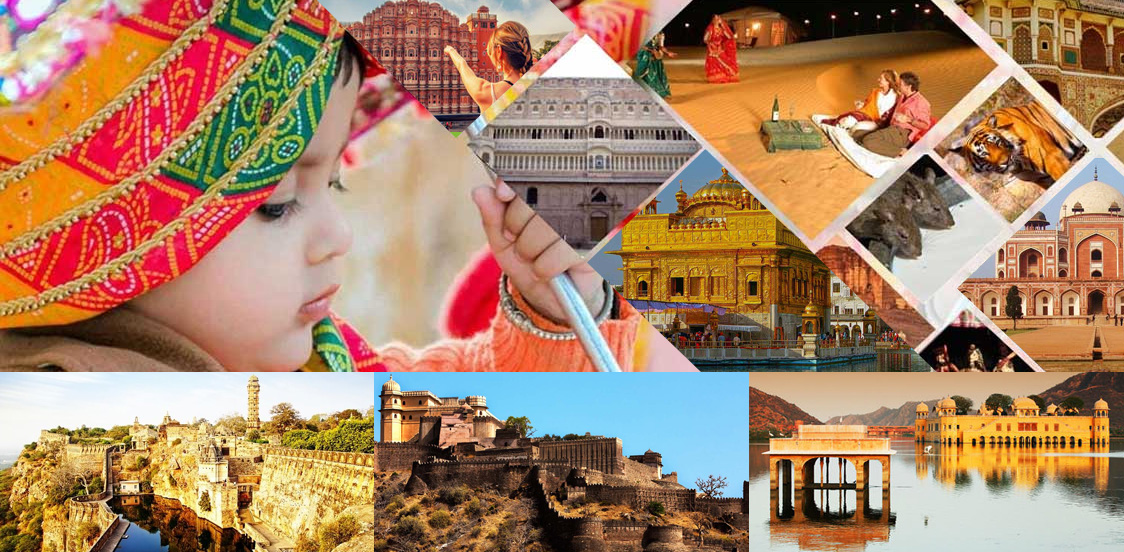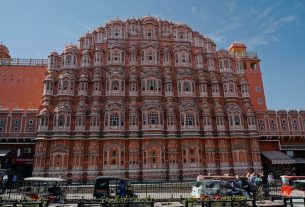Rajasthan has been referred to as the land of the kings and princes, a land of royalty and grandeur. The landscape of Rajasthan is dotted with a number of forts, fortresses, citadels, palaces, and strongholds that speak of the rich history of the Rajput clan and mighty warriors. These forts and palaces of Rajasthan are the main attraction of a visit to this great land. Every other city in Rajasthan has its own fort as a mark of distinction. Many of them are now ruins and are on the brink of extinction, but there are some that have been preserved and restored in their pristine glory.
Kumbhalgarh fort
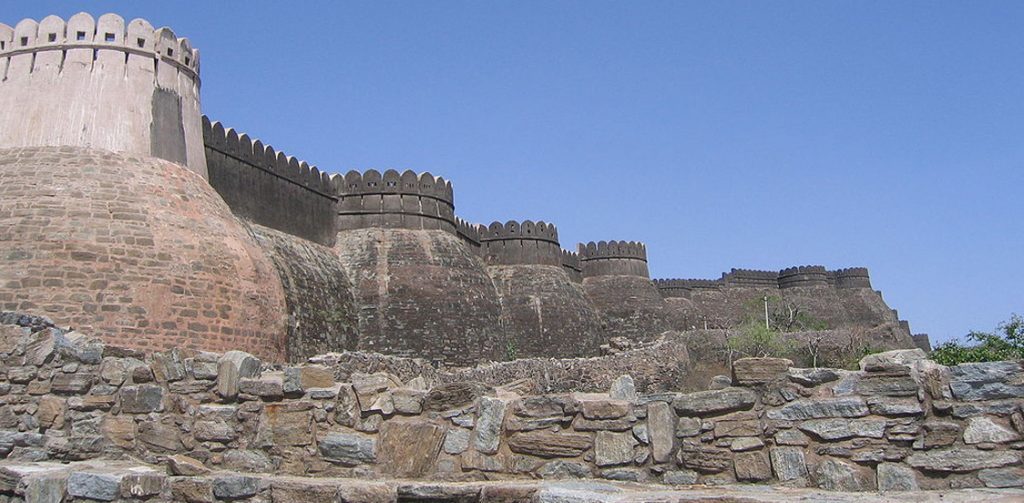
This is the second most important fort of Rajasthan after Chittorgarh which was built in the 15th century A.D. by Maharana Kumbha. It is located 90 km north-west of Udaipur in Rajasthan State and famous for its 36 km long wall which is the second-longest continuous wall in the world. Rounded bastions, soaring watchtowers, and crenelated walls make this fort an impregnable structure which had nurtured Mewar kingdom for centuries. The fort complex houses around 360 temples among which Shiva Temple is worth visiting because of a huge Shivalinga. Apart from this, the fort is also known for its beautiful palace known as ‘Badal Mahal’ or the Palace of Cloud. This is the birthplace of great warrior Maharana Pratap which is renowned for its beautiful rooms with a lovely color combination of green, turquoise and white.
City Palace, Udaipur
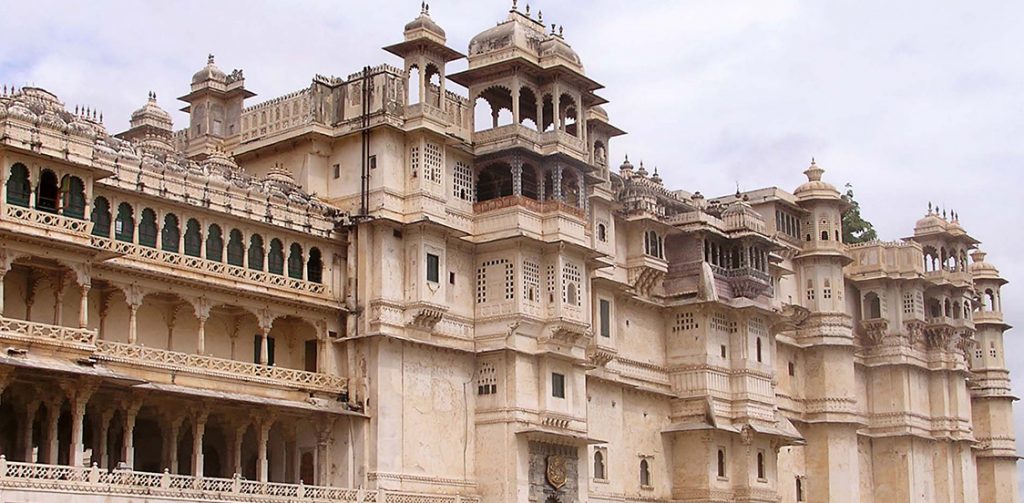
City Palace is the largest palace complex in Rajasthan situated on the banks of Lake Pichola in Udaipur. The structure of its kind, the City Palace is undoubtedly Udaipur’s most iconic edifice. Maharana Udai Mirza Singh built this palace as the capital of the Sisodia Rajput clan in 1559. This palace is the perfect blend of Rajasthani, Medieval European and Chinese architecture. Consisting of eleven castles, the massive palace complex is a treasure trove of architectural marvels that are distinctive to this monumental structure. Towering above Udaipur at an elevation of 1,962 ft, the highlights that should not be missed when touring the City Palace. This palace is known worldwide for its elaborate labyrinth of courtyards and balconies of granite and marbles which are connected together by interspersed passageways and stairs. City Palace is the most romantic attraction of India’s most romantic city ‘Udaipur’ which leaves indelible experience upon tourists who visit it even once.
Best Time to Stay at City Palace: November – February
Opening timing and Closing time: 9 am to 4.30 pm
Udai Vilas Palace, Udaipur
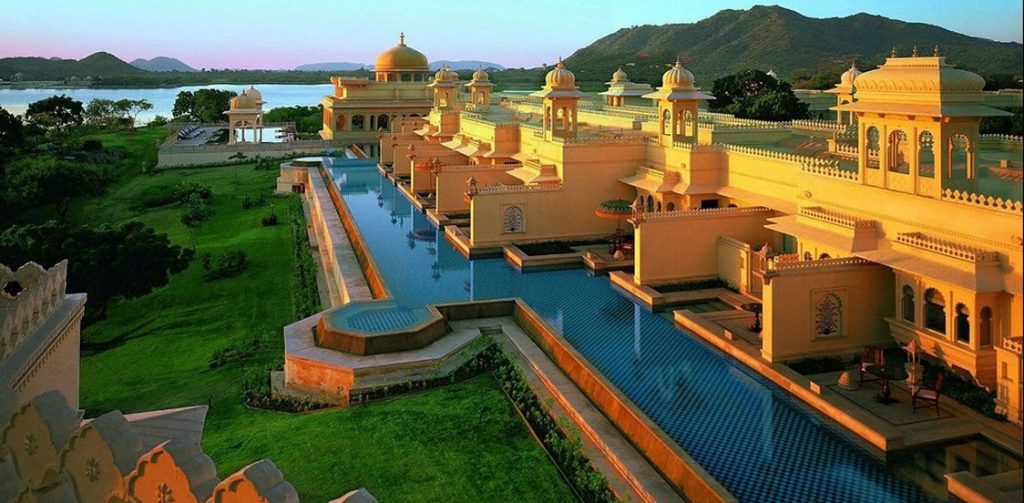
Standing on the 200-year-old hunting grounds, on the banks of Lake Pichola lies the Oberoi Udaivilas Palace. Udaivilas is built in a Mewari style of architecture and consists of carved stone pillars and beautiful water bodies. It features domes, pavilions, gardens and courtyards, and offering mesmerizing views of the surrounding, verdant gardens. Currently, the palace is working as a heritage hotel managed by the Oberoi group. The unique hotel in Udaipur is built on 30 acres of land, which includes a wildlife sanctuary spanning across 20 acres. Fully furnished rooms are equipped with modern amenities like mini bar, bathrobes, compact digital video disc, etc. the hotel provides excellent services like babysitting, luggage storeroom, meeting room, car parking, laundry, spa, post and shipping service and many more. This is the world’s best attraction amongst the forts and palaces in Rajasthan.
Best Time to Stay at Udai Vilas Palace: January – December
Opening timing and Closing time: 12 am to 12 pm and 9 pm to 12 am
Lake Palace, Udaipur
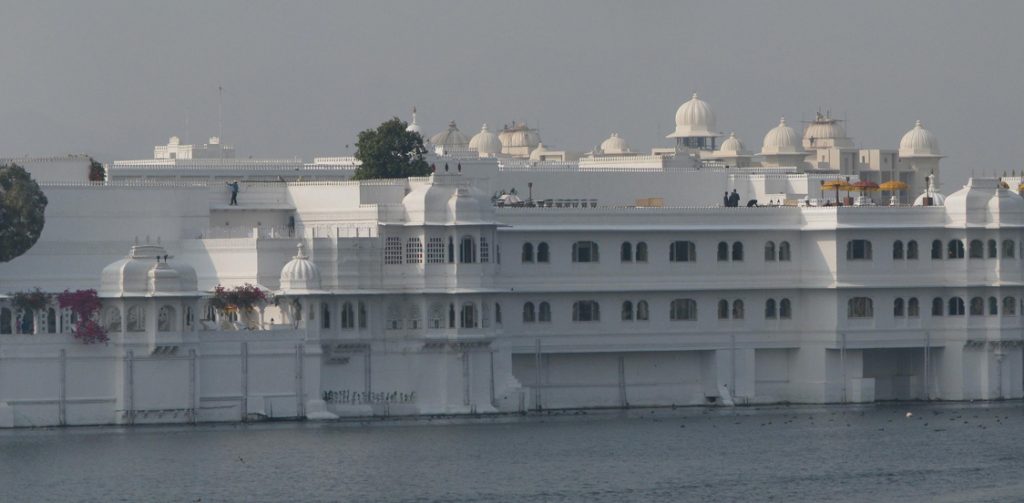
It is one of the most beautiful and romantic places of the world arising out of the azure waters of the Pichola Lake. In the serene waters of Lake Pichola lies this magnificent palace built in the 17th century on a 4 acre of the rocky platform. The palace was earlier called ‘Jaginwas’ after Maharana Jagjit Singh, the founder of Lake Palace. It served as a royal summer palace prior to being converted to a five-star heritage hotel. An opulent luxury can be experienced through its 83 lavish rooms. The architectural splendor of this artistic palace can be seen in the design of cusped arches embellished with pink stones and green colored lotus leaves sculptures and painted mirrors. Some of the most famous complexes of this palace are Dhola Mahal, Phool Mahal, Ajjan Niwas, Kush Mahal, and Badal Mahal. A royal and elegant palace with an excellent taste of intricate craftsmanship, welcome to the Lake Palace in Udaipur.
Best Time to Stay at Lake Palace: January – April and October – December
Opening timing and Closing time: 9.30 am to 4.30 pm
Neemrana Fort Palace, Alwar
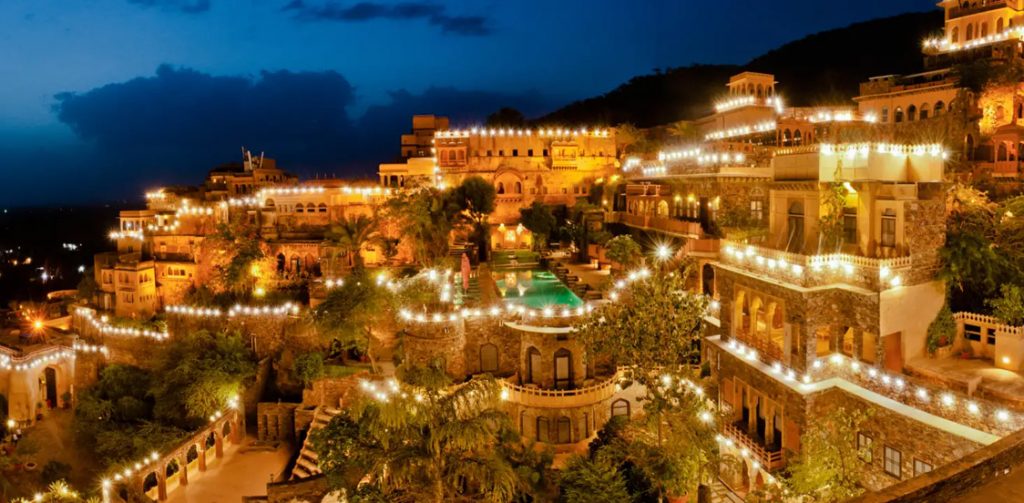
It is among India’s oldest heritage resort hotels created in 1986. It was shifted from Mandhan, near Alwar to Neemrana when the fort was established by Raja Dup Raj in the 14th century. A village in the medieval period, Neemrana became popular after it was made the capital during the Prithviraj Chauhan’s reign. Nowadays, Neemrana fort is a heritage resort and has been gaining a strong presence among tourists. The scenic, historic location set in the Aravalli Hills of Rajasthan, Neemrana is among the best places for a weekend tour. The place is sure to make one enchanted with the history of its bygone era. Neemrana can be visited round the year and there is no dearth of resorts to give the best stay experience.
Deogarh Mahal, Udaipur
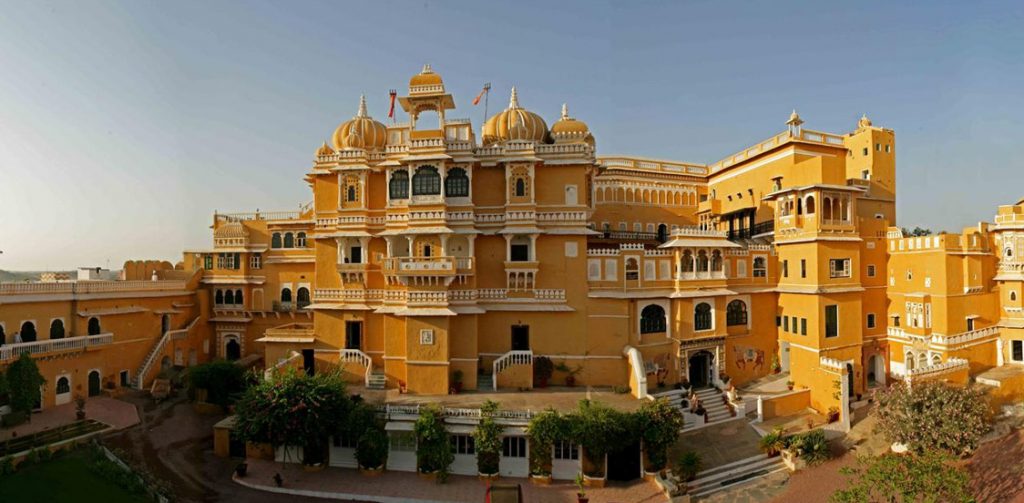
Deogarh is a very significant tourist attraction. The place of Deogarh is located among the woods. Tourists enjoy the picturesque beauty of the place, the flora and fauna and more importantly the historical monuments and architecture of the place. Deogarh is the seat of the Chundawat clan of Sisodia Rajputs. And it is also famous for the Deogarh School of Art. It is the place where you will find the famous Deogarh paintings. The place of Deogarh is situated in a beautiful landscape as the town is surrounded by Bhil villages. This lends color to the town and it is a tourist attraction. It looks immensely attractive as you make your way towards the Deogarh Mahall.
Best Time to Stay at Deogarh Mahal: October – Early April
Opening timing and Closing time: 24hrs open
Chhattar Mahal or Palace of Towers, Bundi
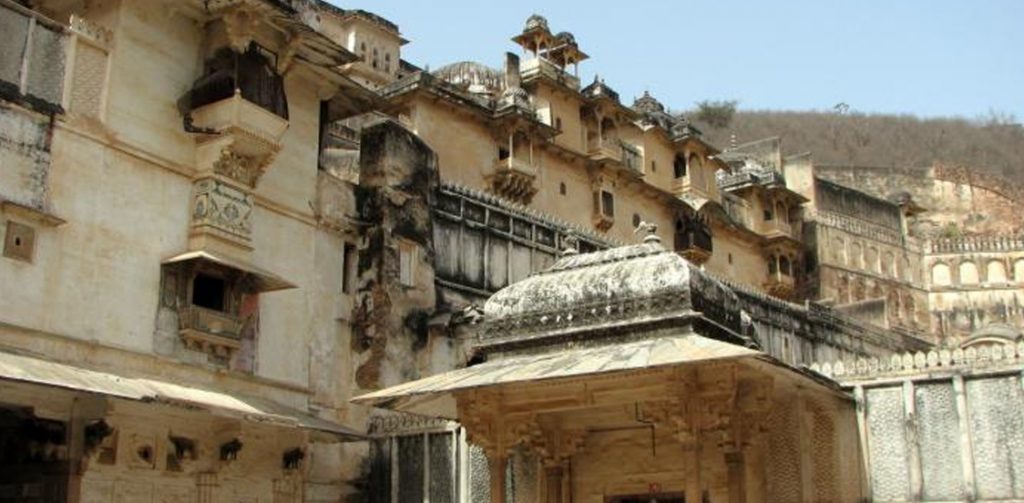
Chhatra Mahal was built by Chhatar Sal in the year 1660 and is a strong proof of the rule of the Rajputs in the region at a time when the Mughals were ruling over India. Unlike the red sandstone monuments that were built by the Mughals, Chatar Sal built this palace using stones from the quarries of Bundi. The interior of the Mahal has mural style paintings while the gates have glass and ivory work on it. A steep, paved path carriage is the only way to reach the monument. Special interest in the palace is the Hazari Pole, the Naubat Khana, the Hathi Pole with its old water clock, and Diwan-e-Aam.
Lohagarh Fort
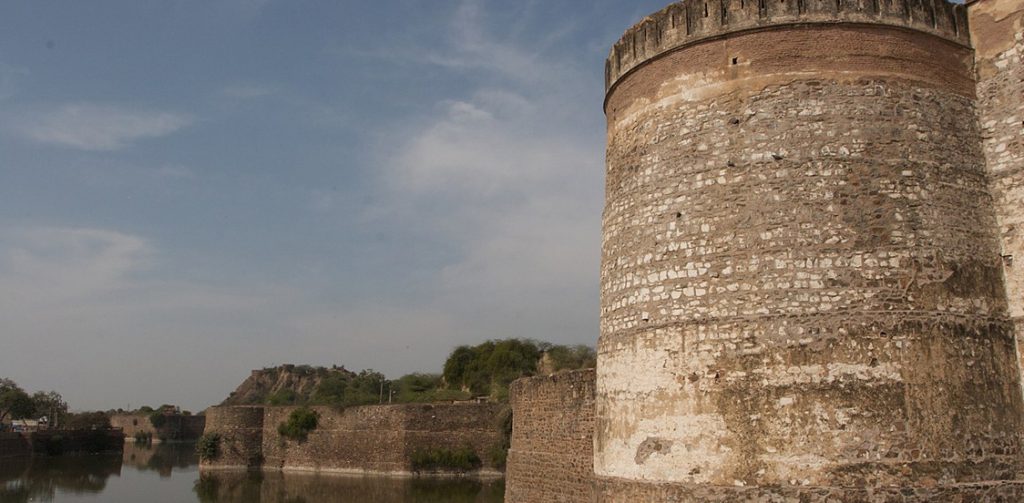
Also known as the Iron Fort, the Lohagarh Fort was built by the Jat ruler Maharaja Suraj Mal in the 18th century. This spectacular fort is named Lohagarh after its impregnable defense system. The fort has an imperial history to boast about and has endured several British attacks. The Kishori Mahal, Mahal Khas, Moti Mahal, and Kothi Khas are the key highlights of this fort. These palaces reflect the grand opulence of the Kings of Bharatpur. Maharaja Suraj Mal, who founded the Lohagarh Fort, had also built two towers, the Fateh Burj and the Jawahar Burj, within its precincts. The design, decoration, and construction of this fort remind us of the glorious era of the audacious Jat rulers. The Ashtadhatu gateway with huge elephants’ paintings is the most striking feature of this fort.
Timings – The Lohagarh Fort is open to visitation at all hours
Price for a single room- Starting from INR 5900/ 90 USD
Location- Bharatpur, Lohagarh Fort, Gopal Garh, Rajasthan 321001
Bundi Palace, Bundi
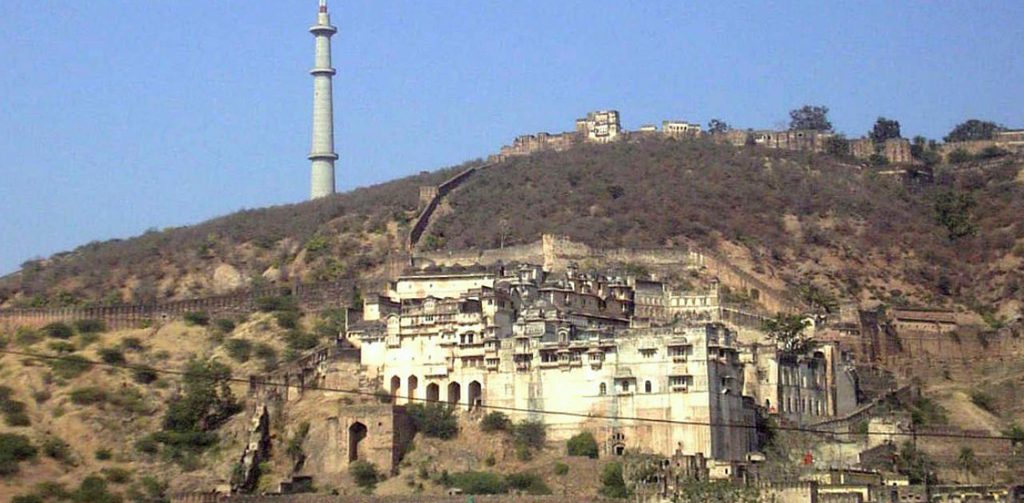
Located next to the Taragarh Fort, this palace is a wonderful example of workmanship. This magnificent edifice is a fine example of Rajput architecture, housing some of the superb Bundi murals. Most of the walls of the palace are adorned with murals. Tourists are not allowed to visit all parts of this palace. They can only visit some of the sections of the palace. One of them is “Chitrashala” which has various miniature colorful murals, depicting “Raslila” and “Ragamala”. If you wish to see all the areas of the palace you need to take special permission from the secretary of the Maharaja of Bundi. When illuminated during night, Bundi Palace gives a beautiful sight. This wonderful palace has a unique combination of natural beauty and historical significance.
Lalgarh Palace, Bikaner
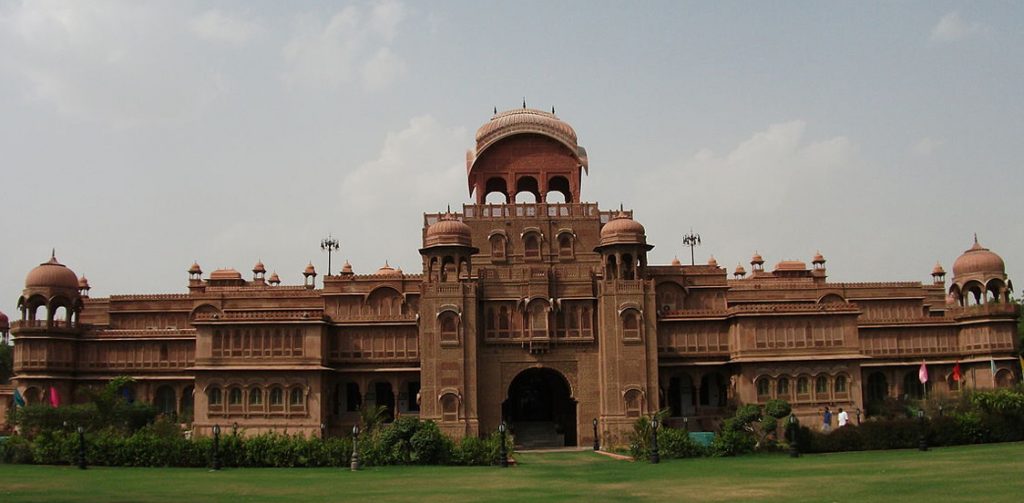
An imposing red sandstone palace, Lalgarh Palace, was built by Maharaja Ganga Singhji in 19 century. Designed by Sir Swinton Jacob, it is a perfect blend of European, Mughal and Rajput style. It is a typical classical beauty of Rajasthan with overhanging balconies and well-refined lattice and filigree decoration. The intricately carving on red stone reflects the skills of great local craftsmen. Inside the palace, one can enjoy beautiful pavilions, lounges, and halls together with the largest library. It has the largest collection of original Sanskrit manuscripts. A portion of the palace has now become a heritage hotel, whereas the other part of the palace serves as the dwelling of the royal family. The palace encompasses a rich collection of impressive paintings and hunting trophies of the old Maharajas. The blooming terraced gardens of this palace are beautifully adorned with Bougainvillea bushes. Peacocks strolling around this huge palace make a great visual treat. This beautiful palace is an oasis amidst the drudgery of the Thar Desert.
Best Time to Stay at Lalgarh Palace : January – December
Opening timing and Closing time: 10 am to 5 pm
Umaid Bhawan Palace, Jodhpur
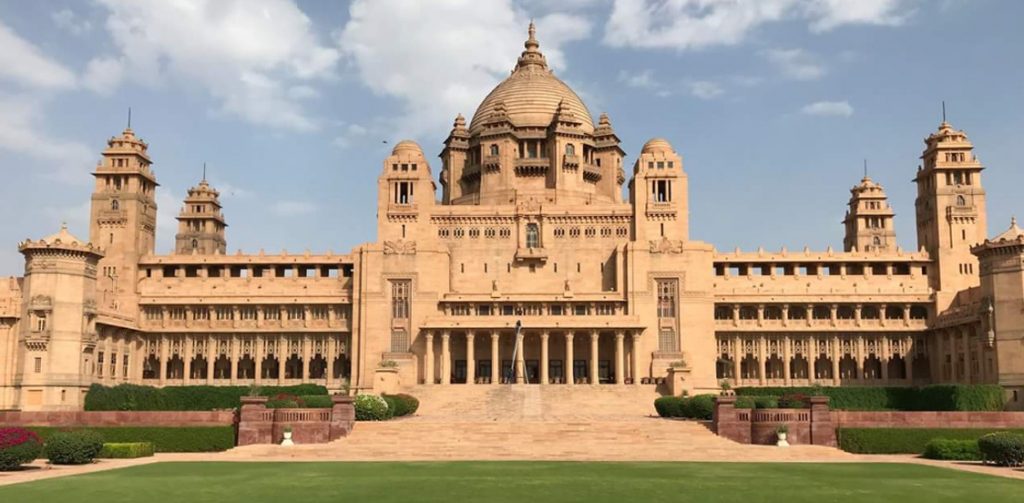
Stunning to the hilt, this palace was once the largest palace in the world. Now for tourism purposes, it has been converted into a heritage hotel. It is primarily used as a residence for the royal family of Jodhpur and is partly managed by the Taj group. Spread across 26 acres, the palace has 347 rooms done in the Art Décor style of interior. It is ideally located on Chittar Hill, it offers bird’s eye view of the city. It is breathtakingly beautiful and was designed by the famous architect Edwardian architect Henry V Lanchester. All the apartments of this palace are different and are decorated in royal style. If you wish to experience the glory of the past, you must visit the majestic Umaid Bhawan Palace. The other attractions include the Throne Room decorated with Ramayana Murals, a library and a museum showcasing a banner presented by Queen Victoria, various weapons, paintings, and other royal articles.
Best Time to Stay at Umaid Bhawan Palace: January – December
Opening timing and Closing time: Open 24hours
Fateh Prakash Palace, Chittorgarh
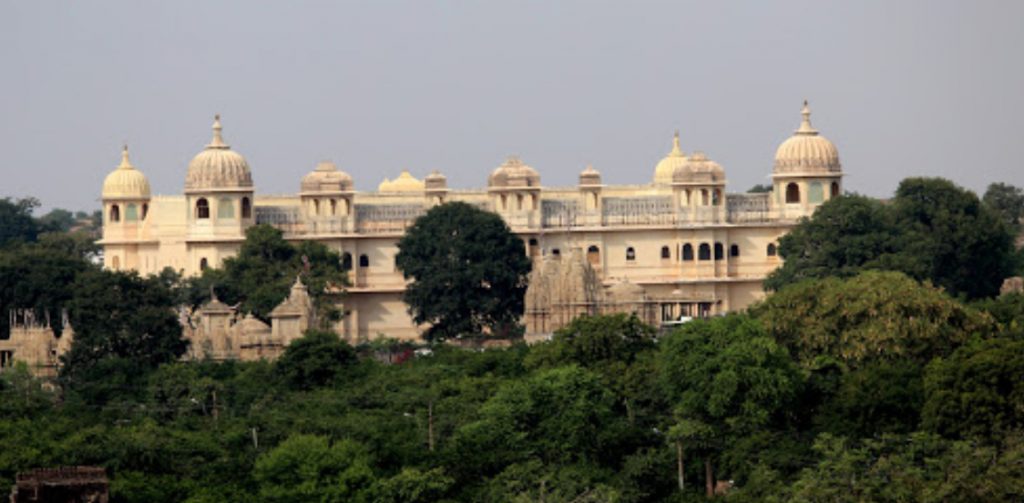
The Fateh Prakash is the modern building in Chittor which was built in the early 20th century and was the home for the Maharana Fateh Singh, Chittor ruler who died in 1930. The erection of this palace was during the reign of Rana Fateh Singh. It lies within the Chittorgarh Fort. The palace served as Rana’s residence. Rana Fateh Singh showcased his inclination towards art and culture through constructing this Palace. The palace is studded with numerous corridors and pillars built in Rajasthani style. It is beautifully decorated with wall paintings showcasing legends from Rajasthan belonging to the 17th and 19th centuries. Later, Fateh Prakash Palace was partially converted into a museum.
Devi Garh Palace, Delawara
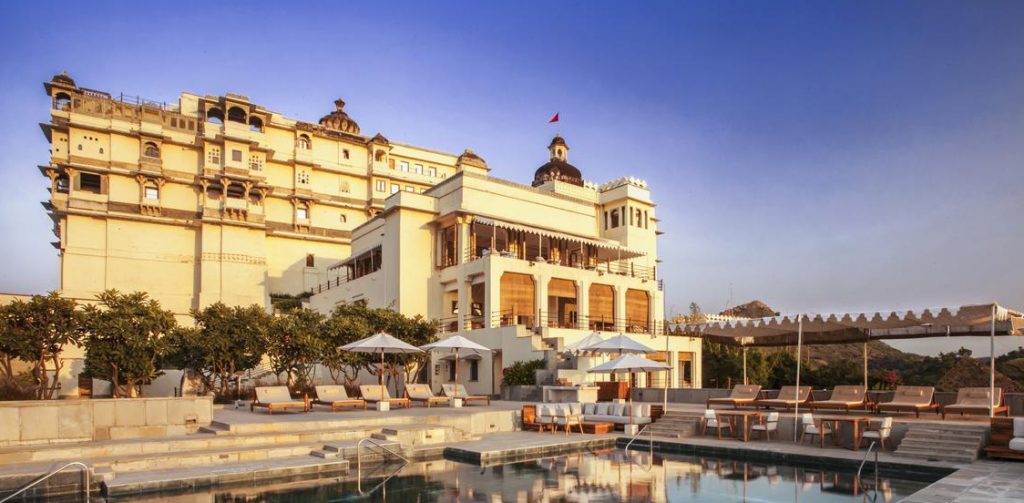
This palace, which is now a hotel was awarded to Sajja Singh in the 16th century for his loyalty to Maharana Pratap. This is another hotel that has been successful in preserving its past legacy and heritage. It is among the most popular hotels in Udaipur nestled in the Aravali hills. The interwoven charm of the traditional decorations and the modern amenities enthrall tourists who come here to stay during their Udaipur tour. This hotel is famous for the captivating blend of old and new designs which make it indistinguishable with any other Udaipur hotels. The hotel is highly popular amongst many film stars and famous people. This hotel has 30 luxurious and beautiful suites equipped with modern facilities and amenities which offers a royal stay to tourists. Each of the suites of this palace is adorned with marble and semi-precious stones which make it grand and elegant in look.
Jag Mandir Palace, Udaipur
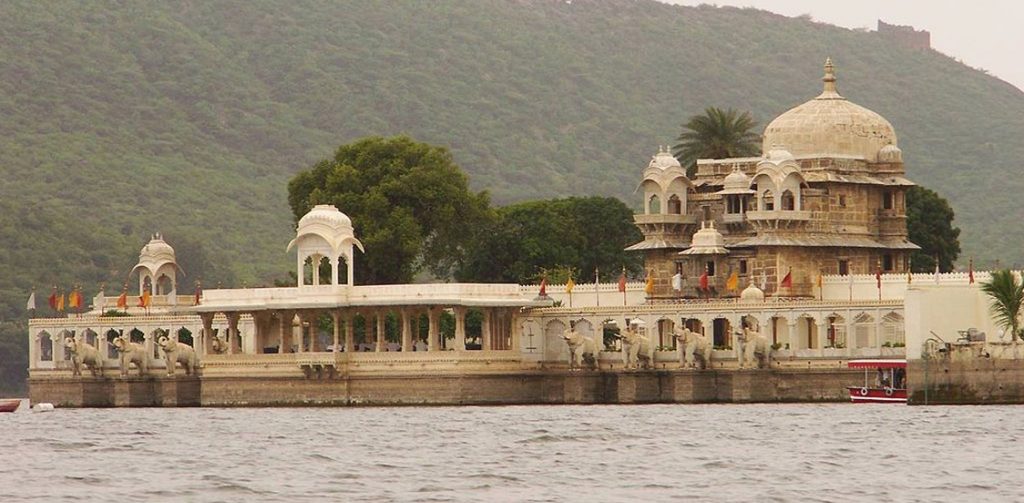
Jag Mandir is an enchanting attraction of the romantic city Udaipur. Royally built on an island in the middle of the beautiful Pichola Lake, it is a must-see attraction. It was built by the three Maharanas of the Mewar Kingdom. Maharana Amar Singh laid its foundation in the year 1551 and its construction work continued by Maharana Karan Singh and finally, it was completed by Maharana Jagat Singh. This wonderful island palace was once the summer resort of the royal family. And it also served as a refuge to asylum seekers on two different occasions. It is also known as Lake Garden Palace. This palace holds sheer historic significance. It’s wonderful and attractive architecture never fails to capture the hearts of onlookers. Its exquisite carvings are a treat to the eyes. Gul Mahal is one of the major attractions of the palace, which reflects Mughal architecture with lavishly decorated interiors. The interior walls were inlaid with beautiful and colorful precious stones like ruby, onyx, jade, carnelian, and jasper. Built-in yellow sandstone, the palace boasts of an imposing dome. The other attractions include its elephant facade with four carved statues of elephants on its sides looks mesmerizing. Bara Patharon ka Mahal, the Zenana Mahal, and the Kunwar Pada ka Mahal are the other attractions of Jag Mandir.
Laxmi Niwas Palace, Bikaner
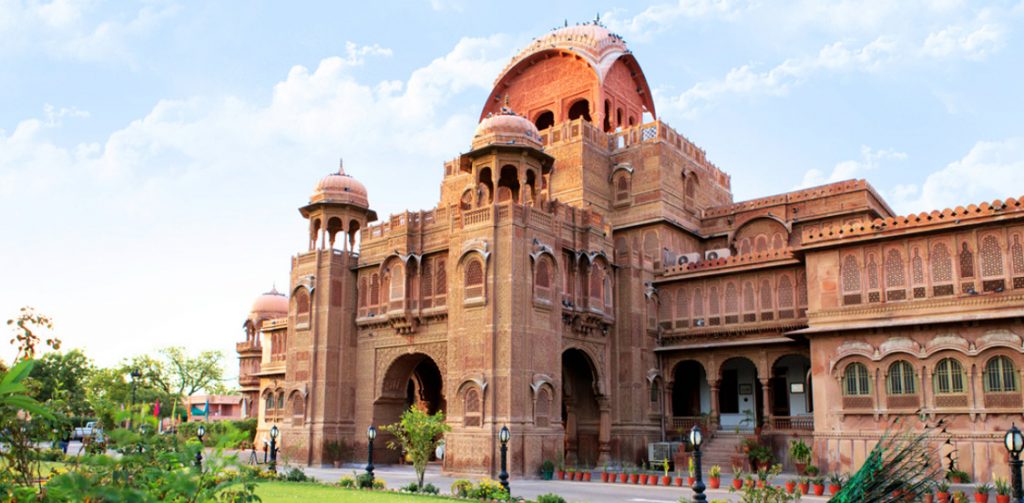
This palace is one of the most visited spots of Bikaner, which was the residential palace of Maharaja Ganga Singh. It was designed by British architect Sir Samuel Jacob. It is a fusion of the Indo-Saracenic style of architecture, which is now converted into a luxury hotel. Laxmi Niwas Palace was designed by renowned architect Swinton Jacob. It is a complete comfort zone offering warm hospitality and outstanding services. The heritage hotel consists of 60 elegantly appointed rooms fitted with the latest amenities. They look very impressive with carved ceilings, gold plated beautiful paintings and traditional artifacts. The hotel provides the facilities like currency exchange, safe deposit, direct dialing telephone, courier facility, postal services, mini bar, smoking rooms, conference facilities, 24 hrs room service, swimming pool and a lot more.
Gorbandh Palace, Jaisalmer
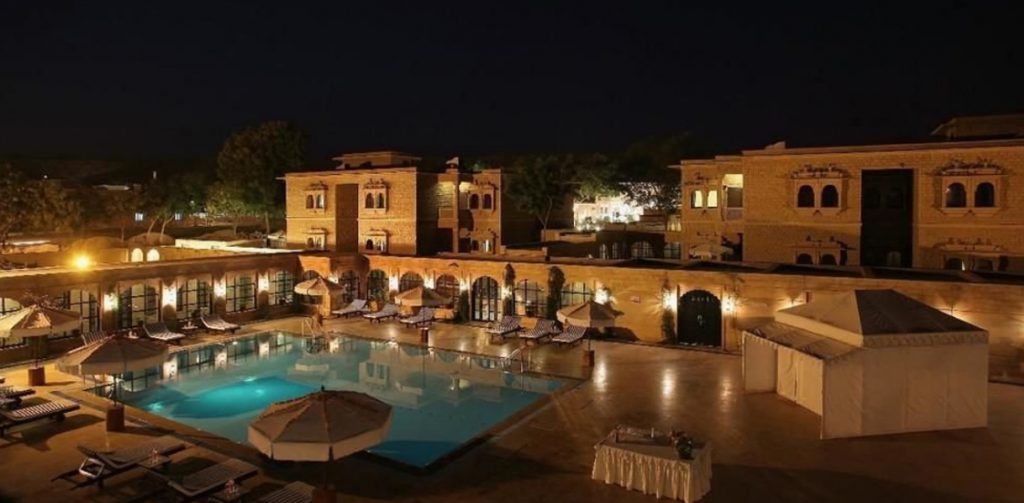
One of the finest vintage Jaisalmer hotels, Hotel Gorbandh Palace. Gorbandh Palace has been constructed entirely of yellow sandstone with intricately cut and carved out balconies adorning the palace. This hotel lies on the way to the Sam Sand Dunes. There is a central courtyard surrounded by peace and have world famous Havelis, a stone’s throw away. The highlights of the property include state-of-the-art Spa, azure waters of the swimming pool, Aashka- Souvenir and Lifestyle Boutique and more. You can gorge upon traditional cuisines at Rasoda and can move towards Madhushala for enjoying choicest of drinks, lip-smacking cuisines and more. The hotel houses 64 deluxe and 3 special suites. Besides offering hi-fi technologies, the hotels also offer some of the most relaxing recreational activities like safaris, puppetry show, and even musical programs.
Sariska Palace, Alwar
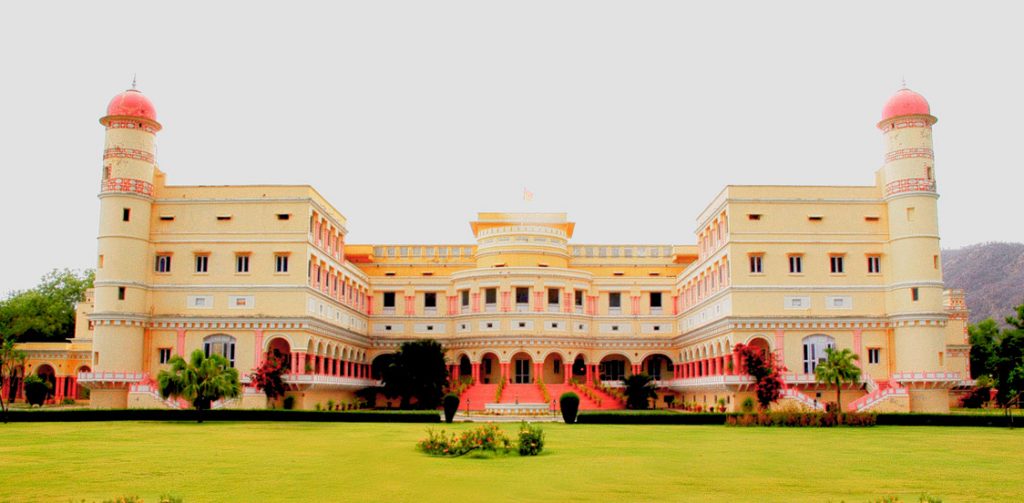
This former palace & royal hunting lodge on the edge of Sariska National Park was built by the Maharaja of Alwar, for the visit of Queen Victoria’s son, the Duke of Connaught. Well-maintained Sariska Fort Palace was built in the 19th century and is spread over an area of 120 acres on the edge of Sariska National Park. The Sariska Palace boasts of the lovely flower-bedecked grounds and beautiful interiors which are a fusion of regal and French architecture. The palace is now a Heritage Hotel with eastern detailing interior and some Louis XIV & art deco furniture. It has gigantic rooms & suites with high ceilings and offers exhilarating views of flocks of migratory birds and even a tiger, on a rare occasion.
Deeg Palace, Bharatpur
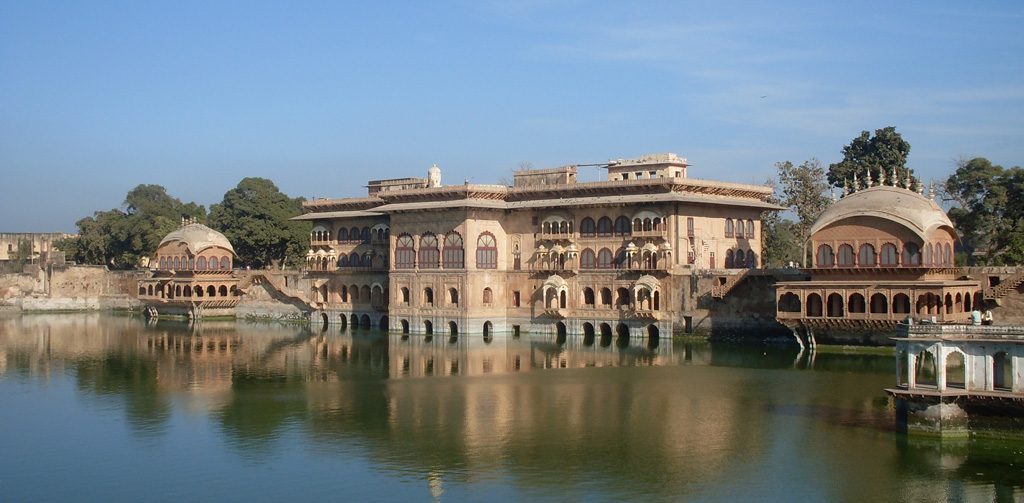
Deeg Palace is a beautiful and massive fortress and it has been a summer resort of some of the rulers of Bharatpur. Located 32 km North of Bharatpur, it displays the meticulous engineering skills of the then era beautifully. The palace is filled with multi-hued fountains, spacious pavilions, and eye-catching arcades. It also has then-available equipment to simulate thunder sounds. Deeg Palace is a notable destination with magnificent and exceptionally elegant gardens. The architecture of the fort is best seen through its various bhawans which include Suraj Bhawan, Gopal Bhawan, Kishan Bhawan, Nand Bhawan, Nand Bhawan, and Keshav Bhawan.
Timings: 9 AM to 5 PM (Sat-Thu)
Udai Bilas Palace, Dungarpur
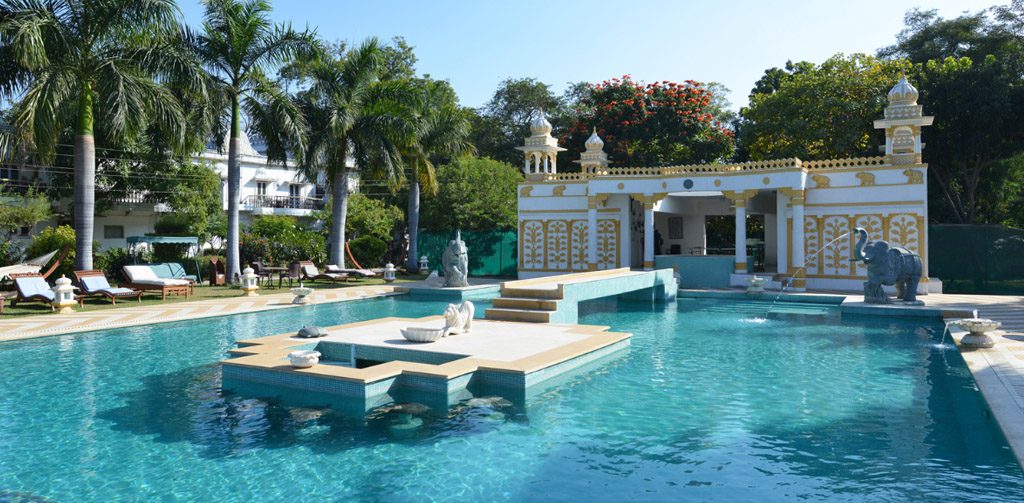
Udai Bilas Palace is named after a Maharana of Mewar and the founder of the city of Udaipur, Maharawal Udai Singh II. It was built in the 19th century grey-green granite in a blend of Mughal and Rajput style. Its architecture features minutely carved balconies, arches, and windows. Raniwas, Udai Bilas, and Krishna Prakash are the key attractions of this palace with exquisite architecture. Located on the banks of a serene lake, Udai Bilas Palace is known for its grand royal elegance and overlooks the beautiful lake. A building that is nicely decorated with miniature paintings, carved stones, and fine murals, Udai Bilas has the most elegant and magnificent architecture.
Mihir Garh, Jodhpur
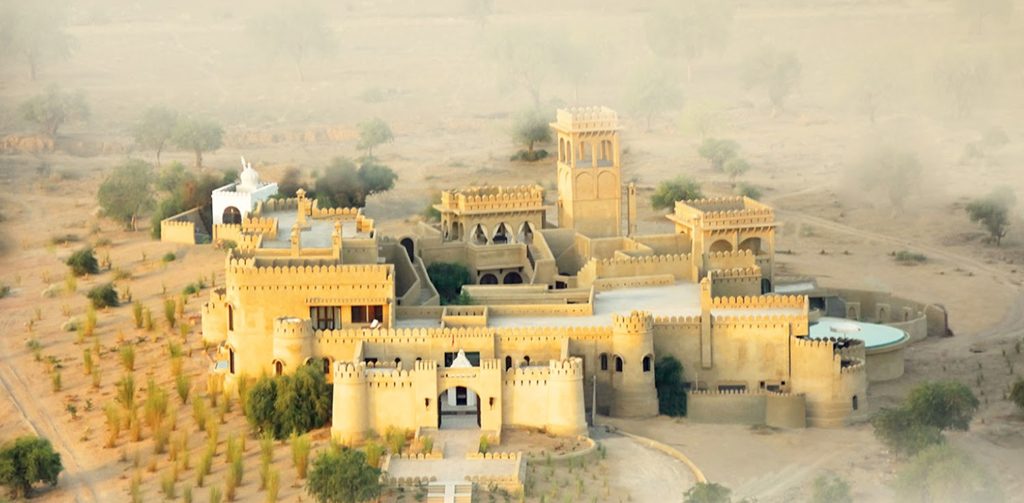
Castle Mandawa
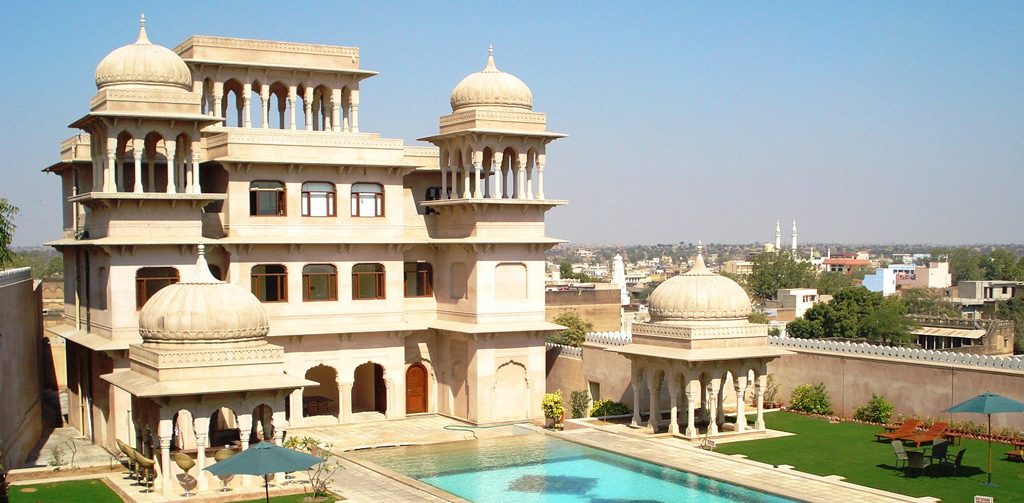
Castle Mandawa is a beautiful palace turned hotel, standing tall and proud as a testimony to the charming and colorful city of Mandawa. Castle Mandawa is situated in the town of Mandawa which lies in the middle of the desert state of Rajasthan. This comes under the Shekhawati region, a place blooming in myriad colors amidst the golden desert. Castle Mandawa was originally a palace and a fortress which have now been converted into a luxurious heritage hotel. It is truly regality at its best where the visitors admire its palatial architecture. The regal family of Mandawa generously decided to share the redefined elegance and mighty glory of this beautiful work of art with the world and converted it into a luxurious and lavish heritage hotel.
Samode Palace, Jaipur
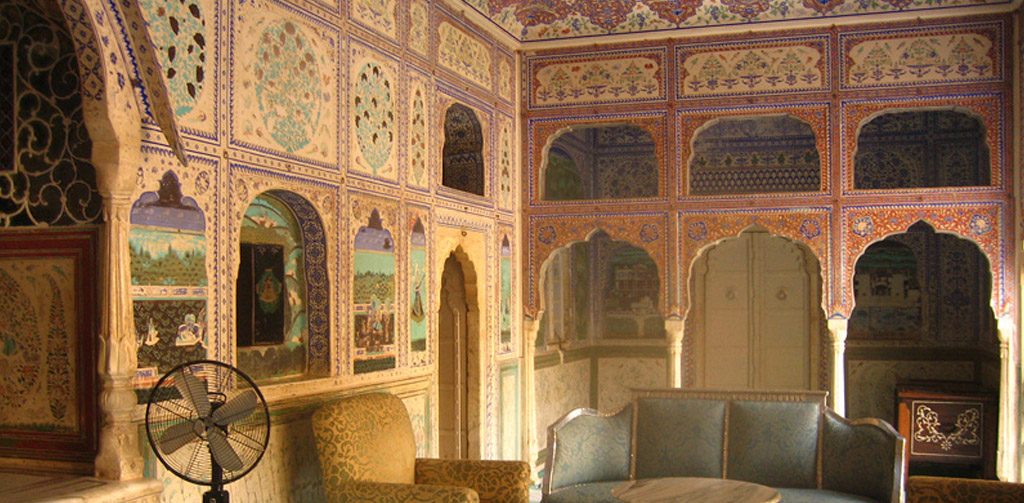
Located amidst the barren hills of the Aravallis, Samode is a gem in itself. It is renowned for its impressive Havelis and forts. It is the place of immense importance for all those interested in the royal anecdotes of the past. Lying at a distance of 42 kilometers from Jaipur and 264 kilometers from Delhi, Samode is India’s most charming heritage hotel. It is the 400-year-old property, which is now converted into a heritage hotel and is run by the Samode family. For the consecutive five years, it has been awarded as the best Heritage hotel in the country. It facilitates the tourists with the most elegant, luxurious and comfortable atmosphere. Presenting the perfect example of the Rajput-Mughal architecture, Samode brings you one of the most unforgettable experiences of a lifetime.
Timings : The check-in time for the palace is from 2 pm to 5 pm and check out time is at noon.
Location Jaipur, Village Samode, Sub-District Chomu, Rajasthan 303806
Bal Samand Lake Palace, Jodhpur
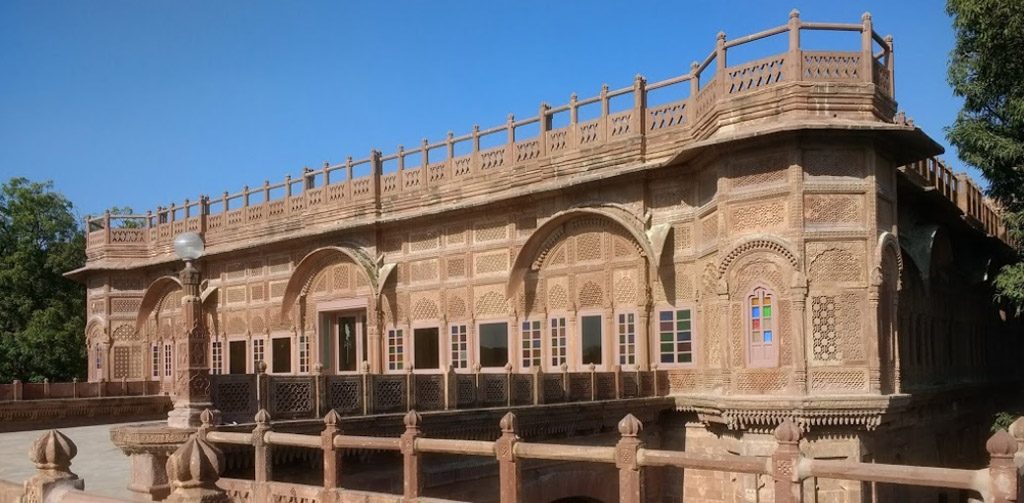
The Balsamand Lake Palace Hotel is one of the most famous heritage hotels in Jodhpur. The Balsamand Lake Palace Hotel is famous for its traditional Rajasthani cuisine and also has a fine collection of liquors. The hotel is situated on the Balsamand Lake and offers breathtaking views from each of the 36 rooms. This hotel is decorated with original Rajasthani curtains and Drapes and also has traditional and original Jodhpuri furniture. The terrace offers some excellent views of the lake and is a perfect place to spend the evenings with the pleasant breeze blowing from the lake. It caters to both business and leisure travelers. The interiors of this Jodhpur heritage hotel are adorned with many frescoes and vivid wall paintings of kings and tales of heroism.
Timings : The Bal Samand Lake Palace is open to visitation at all hours.
Price : For a single room- Starting from INR 5950/91 USD
Location : Jodhpur, Mandore Road, Rajasthan 342026
Monsoon Palace, Udaipur
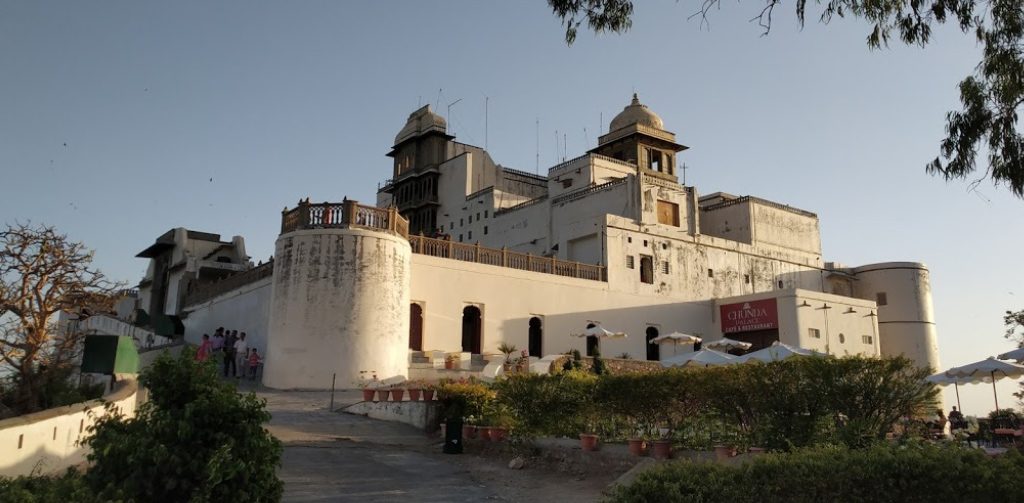
The Monsoon palace also known as Sajjangarh is named after Maharana Sajjan Singh. Constructed atop a hill, the Monsoon Palace was built in the 17th century with a purpose to overlook Maharana Sajjan Singh’s hometown, Chittorgarh. It is a royal fortress that was used during the monsoon season to keep a track of monsoon clouds. The charming construction and the incredible style make this place completely different from the rest of the forts of Rajasthan. The Sajjangarh wildlife sanctuary is a place to visit when travelers spend exploring the imperial castle. Soaring to almost 1000 feet above sea level, this palace is smaller than the others in the city but what it lacks in size, it overcompensates with breathtaking views.
Timings : The visiting hours of the Monsoon Palace are from 8 am to 6 pm
Price: Entry fee for a single person- INR 10 for Indians and INR 80 for foreigners
Location : Rajasthan 313011, Kodiyat
Junagarh Palace, Bikaner
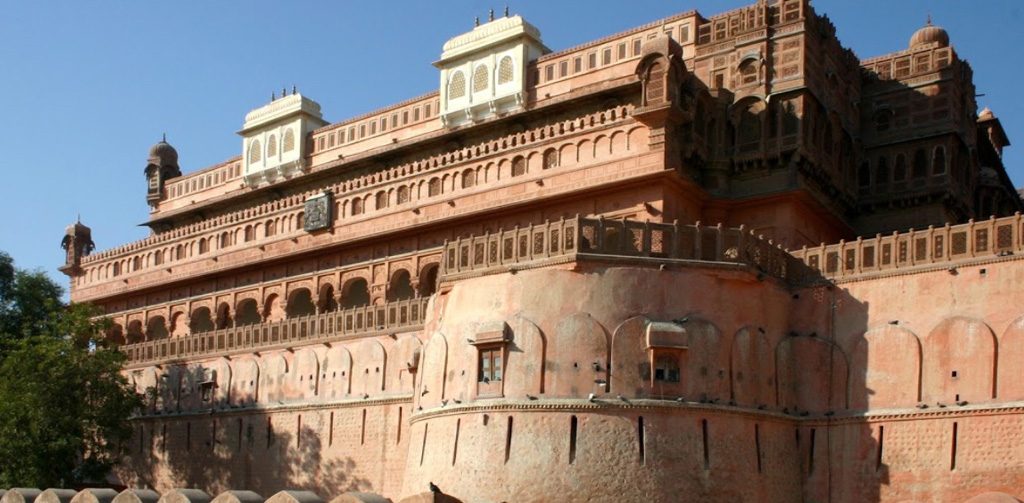
Junagarh palace is one of those palaces in India, which was never conquered by the enemy army. Great preservation efforts have helped a great deal in keeping the beauty and grandeur of the fort intact. Built-in the year 1588 AD by Raja Rai Singh, the fort is a rare example of a medieval period monument. Built with red sandstone and marble, and decorated with gold polish, mirror work, enamel work, and lime plaster this palace is one of the rarest forts in India. It is the only fort, which has not been built on the hilltop. Rang Mahal, Anup Mahal, and Ganga Niwas, are the major attractions inside the Junagarh Palace. Of them, Anup Mahal, Chandra Mahal, and the Phool Mahal showcase the most opulent interiors in the palace. Junagarh fort ranks among the most attractive forts of Rajasthan.
Timings : The Junagarh Palace is can be visited from 10 am to 430 pm
Price : Entry Fee for a single person- INR 50 for Indians, INR 300 for foreigners, INR 30 for Indian students, INR 150 for foreign students.
Location : Bikaner, Junagarh Fort Road, Rajasthan 334001
Mandir Palace, Jaisalmer
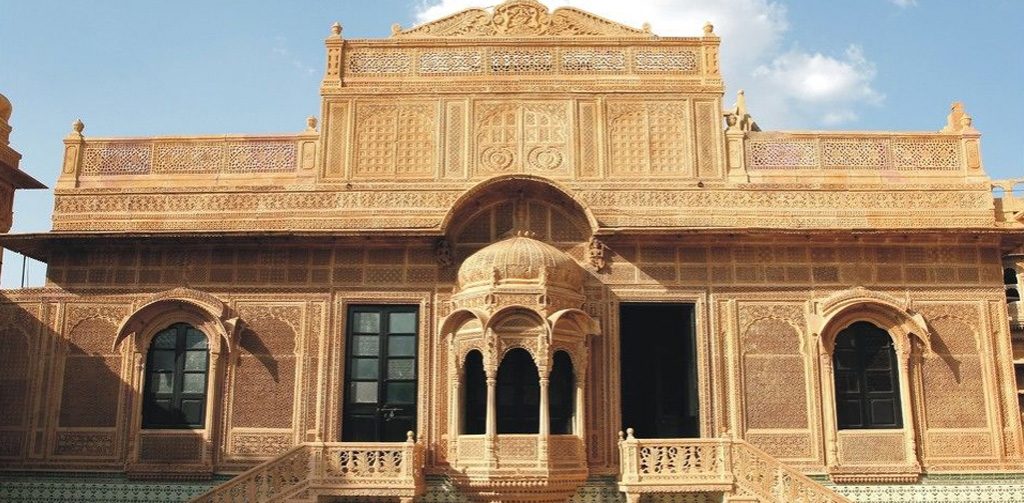
Rohet Fort, Jodhpur
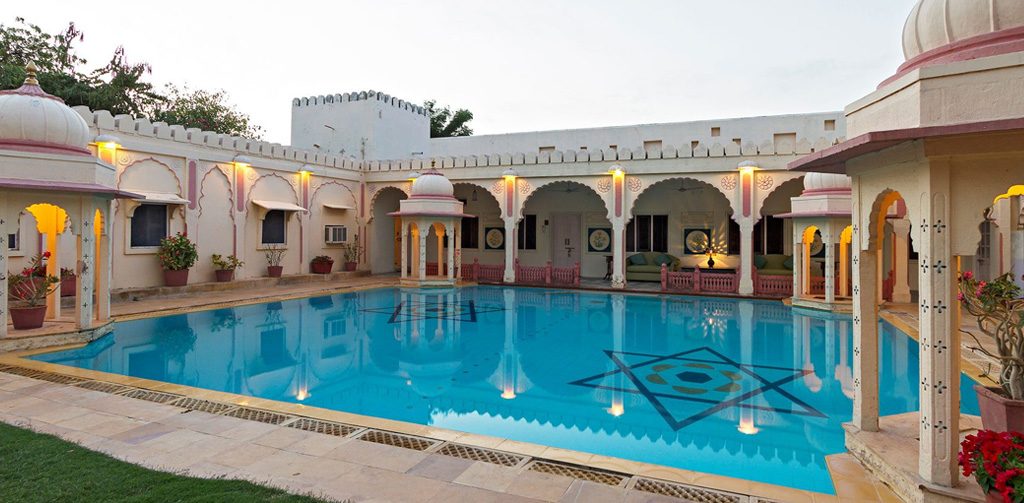
Khimsar Fort
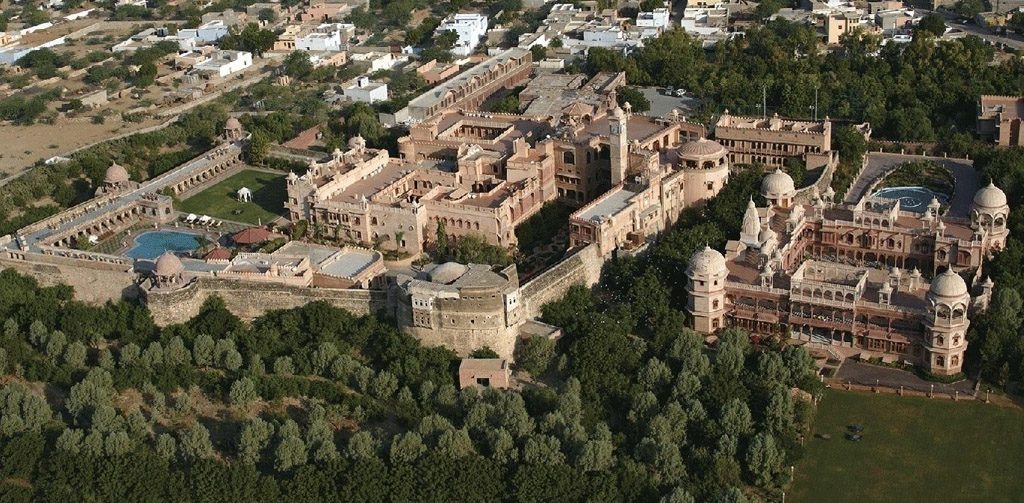
This magnificent fort was built by Rao Karamsi in the 16th century and is situated 90 km from Jodhpur. It is situated on the edge of the great Thar Desert in the heart of rural Rajasthan. Basically, it was built for military purposes to protect the kingdom from invaders and attackers. Presently the fort is owned by Thakur Onkar Singh, who is the 17th direct descendant of Rao Karamsi. Successors of the royal families added various structures to this fort, which heightened its architectural beauty. During the visit, one can witness the personal touch of design and decorations of various rulers who ruled it for centuries. Some sections of this fort and palace have been converted into a grand hotel which is owned by the Welcome heritage group. This fort is counted among the best forts of the state which attracts tourists through its architectural splendor, magnificent design, elegant decorations and collections of yesteryear artifacts.
Bhangarh Fort
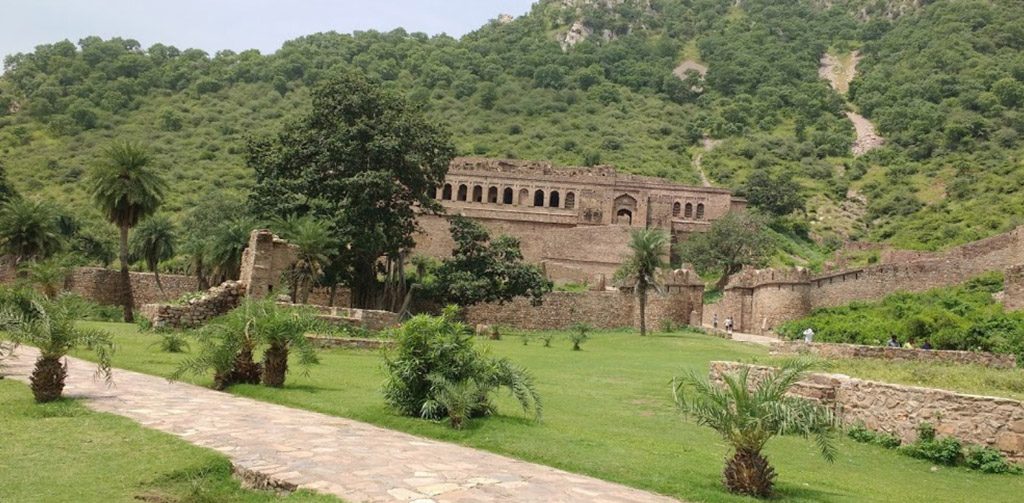
Bhangarh is a deserted town with some 10000 dwellings established in 1613 by Madho Singh, son of great Mughal general, Man Singh of Amber. It is located at the border of Sariska Tiger Reserve in the Alwar district of Rajasthan. Bhangarh was abandoned soon after being built and supposedly after it was cursed by a magician. Bhangarh fort offers an intact view of the medieval past. Apparently, the Bhangarh town had been desolated by an old Mughal invasion and is just reverting back to being habited again. This Fort is infamous for being “The Most Haunted Place” in India. These fort ruins have an eerie and extremely negative aura to them. Numerous paranormal activities and sightings have been reported in the fort due to which no villages lie in its vicinity. Archaeological Survey of India has placed a hoarding at its entrance, forbidding the tourists or locals to enter the fortress before sunrise and after sunset.
Chittor Fort, Chittorgarh
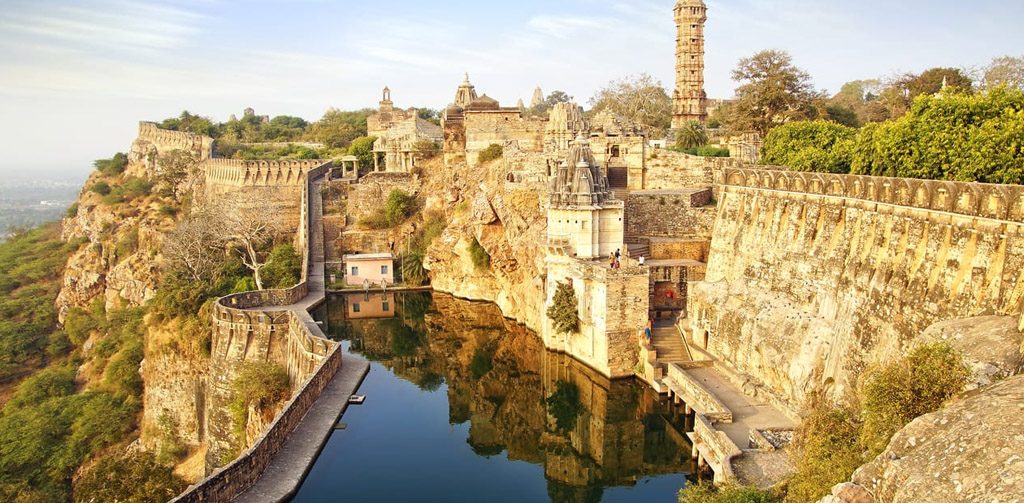
The Fort of Chittorgarh is the largest and grandest fort of Rajasthan as well as of India. Located in Chittor, the city in Mewar region of Rajasthan, It is among the prominent attraction of Rajasthan tourism. It is perched on a 180 meter high hill and sprawl over an area of 700 acres. The Fort gives you an insight into the life of the Great Rajputana dynasties who ruled this fort for centuries. This fort can be accessed through the entrance gates like Padal Pol, Hanuman Pol, Ram Pol, and Bhairon Pol. The fort houses a number of palaces within the complex, which include Rana Kumbha Palace, Fateh Prakash Palace, Padmini’s Palace and more. This magnificent fort is known for its impressive 13-kilometer long wall and soaring towers. The Vijay Stambh also called Victory Tower is an imposing 37 meters high nine-storied structure covered with exquisite sculptures of Hindu deities. While the Kirti Stambh or the Tower of Fame is a 22 meter high tower dedicated to Adinath Ji, the first of the Jain Tirthankaras. These both are the most striking monuments of this fort.
Lakshman Sagar
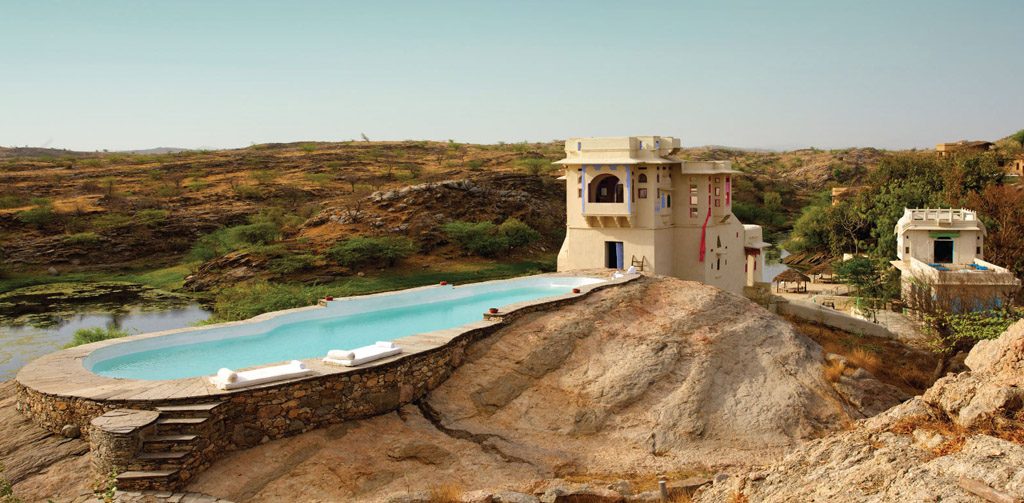
Jaisalmer Fort, Jaisalmer
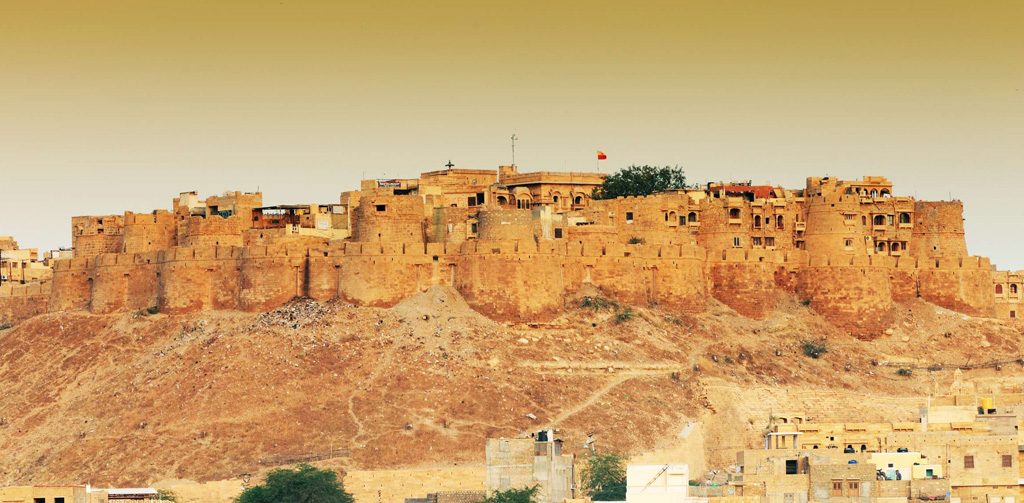
Jaisalmer Fort or the Sonar Quila draws its name from its founder, Rawal Jaisal. The Bhatti Rajput ruler built the fort in 1156 AD on the Trikuta Hill amidst the famous Thar Desert in Jaisalmer India. The fort is one of the largest in the world and still has a major population of Jaisalmer residing within the premises. Earlier the entire population lived inside the fort, but with the passage of time and increase in population, it became increasingly difficult to do so. So, quite a number of them began to settle in the foothills of Trikuta. Today, Jaisalmer Fort is probably the only one that displays how life is within the fort premises. As with other forts of Rajasthan, the Jaisalmer Fort has also seen bloody battles fought and mass suicide or Jauhar committed by the female folks. The major attraction of Jaisalmer fort is its magnificent size – two hundred and fifty feet tall with sandstone battlement wall rising to thirty feet. The fort has ninety-nine bastions and four huge gateways. Other structures within the fort that impress visitors with their charm are the Raj Mahal, Jain temples, Laxminath temple, and Merchant Havelis.
Mehrangarh Fort, Jodhpur
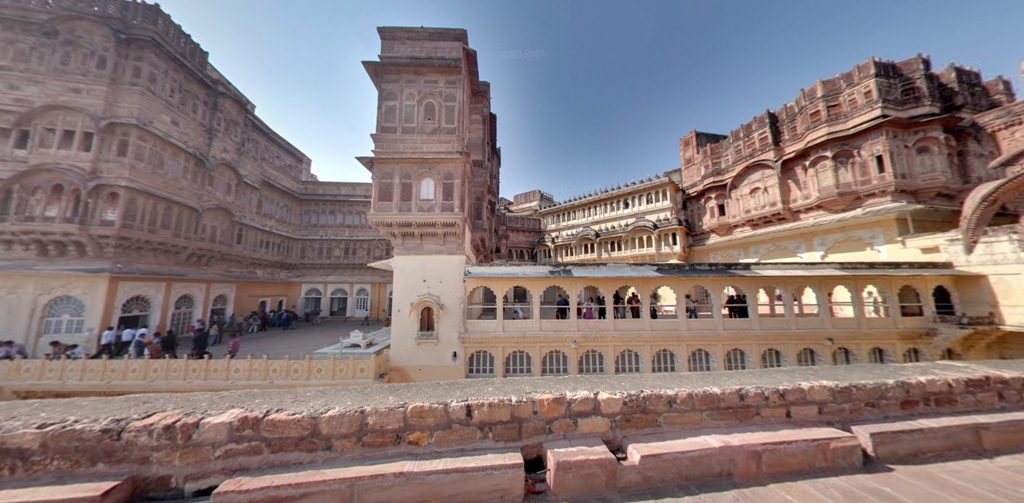
It is among the most impressive as well as the biggest forts of Rajasthan which is located about 5 km from Jodhpur in the state of Rajasthan. This magnificent fort is perched at a height of 122 meters above sea level and enclosed by imposing thick walls of red sandstone. It was founded by Rao Jodha the fifteenth Rathore ruler in 1459. This fort comprises of a number of complexes which include palaces, sprawling courtyards, gates, temples, galleries, and museums. Some of the known attractions of this fort are the Sileh Khana, Moti , Sheesh Mahal, Phool Mahal, and Daulat Khana. The museum of this fort houses a rich collection of instruments, miniature paintings, palanquins, furniture, costumes, royal cradles, and armory.
Taragarh Fort, Bundi
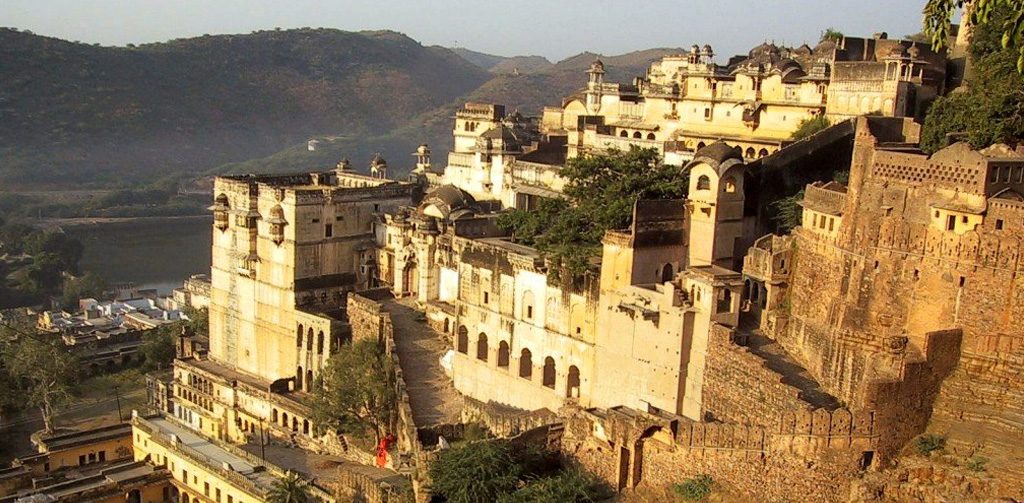
This magnificent fort was built in the 14th century. Built in the 13th century, this fort is perched on the slope of a high hill. This magnificent fort gives a panoramic view of this city. There are two main attractions inside the fort- the Bhim Burj is a huge battlement with a cannon placed on it and a huge reservoir carved out of a single piece of rock. The entrance of this fort has a huge gateways named Laxmi Pol, Phuta Darwaza, and Gagudi Ki Phatak to enter the court. These gates have wonderful elephant carvings. This fort has various tunnels, which have played significant roles at the time of war as it gave a secured exit for the kings and other dignitaries. Tourists are not allowed to enter these tunnels. The fort has mural paintings which showcase the charm of the Rajput era.
Gajner Palace, Bikaner
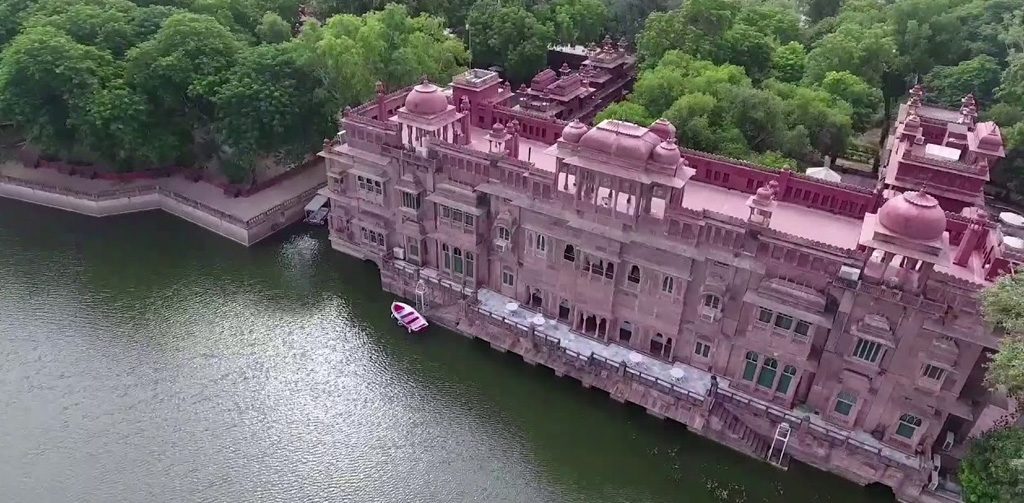
The Gajner Palace has been listed as a summer resort of the Maharajas of Bikaner. The visitors’ guide to Bikaner also refers to this Palace as ‘an incomparable jewel in the Thar desert’. The palace is an addition to the beauty of Bikaner by Maharaja Ganga Singh ji of Bikaner. The palace is situated on the embankment of a beautiful lake and was used by the Maharaja for lavish entertainment and grand shoots. This palace has entertained both Indian as well as International Royalty such as Viceroys and other dignitaries. Gajner Palace is surrounded by lush greenery. Built in red sandstone, the stunning structure served as a hunting lodge for the Rajput rulers. The place is also a great delight for the wildlife enthusiasts as a wildlife sanctuary is located in close proximity to the hotel.
Mandawa Fort, Shekhawati
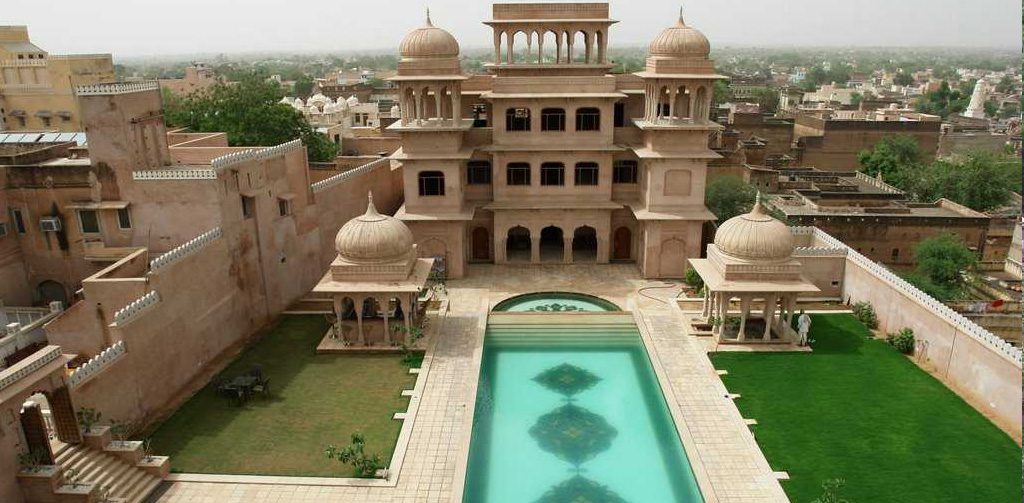
Dating back to the 18th century, this magnificent Rajasthan fort was built by Thakur Nawal Singh. Dominating the landscape of this historic town, the fort has a beautiful gateway painted with the pictures of Lord Krishna and his cows. Reflecting the medieval theme, the interiors of the fort are festooned with beautiful frescoes. You can see amazingly decorated apartments with intricate carvings, paintings of Lord Krishna, and stunning mirror work. Each of its apartments encompasses different themes. Visit the Durbar Hall, where several paintings and antiques are on display. And to offer a royal and unique experience to tourists, the fort has been converted into a heritage hotel. The royal rooms open onto terrace offering enchanting views of the town. Located in the Jhunjhunu district of Rajasthan, this destination comes under Shekhawati region.
Castle Bijaipur, Bijaipur
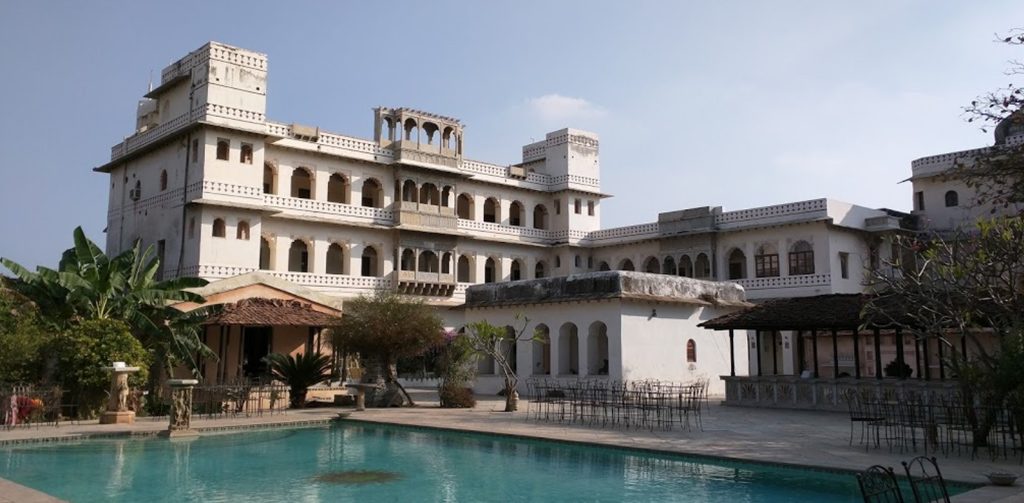
Ranthambore Fort, Sawai Madhopur
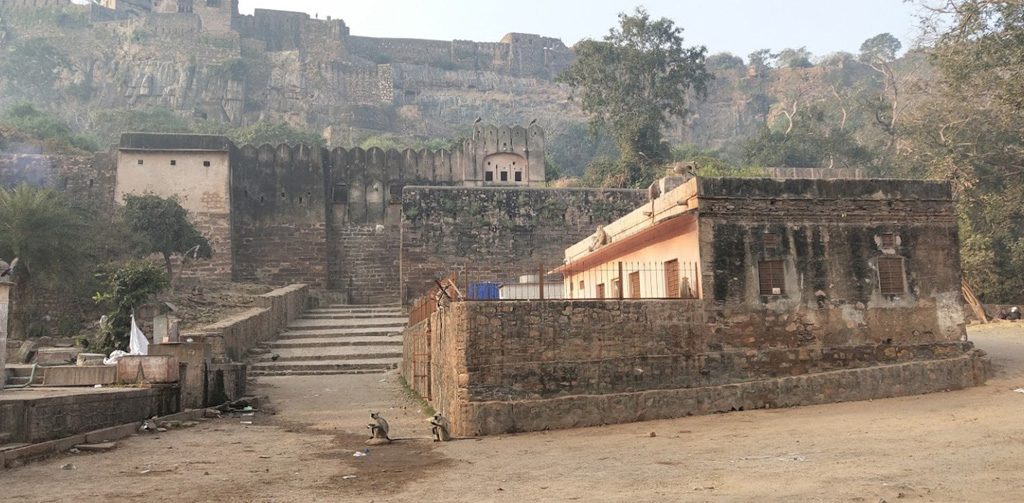
Ranthambore Fort is a formidable fort situated near Sawai Madhopur town in Rajasthan. This grand Fort is located atop a rocky outcrop in the middle of a dense forest at the convergence Aravali and Vindhya hill ranges. It is surrounded by Ranthambore National Park, which was the hunting grounds for the Maharajas of Jaipur before Indian independence. The fort is huge and spread over an area of approximately 7 kilometers. The name of this fort is derived from the nearby Thanbhore and Ran hill on which it is perched. It is one of the best Forts in Rajasthan Which was built by the Chauhan warrior in 944 AD. This fort was bounded by huge stone walls and reinforced by towers and bastions. The fort is accessible through a narrow valley which had four fortified gates. The Hammir court is the leading attraction of this fort known for an outstanding acoustic ambiance where even a murmur gets echoed. This amazing feature spellbound tourists during their visit to this man-made marvel.
Amber fort, Jaipur
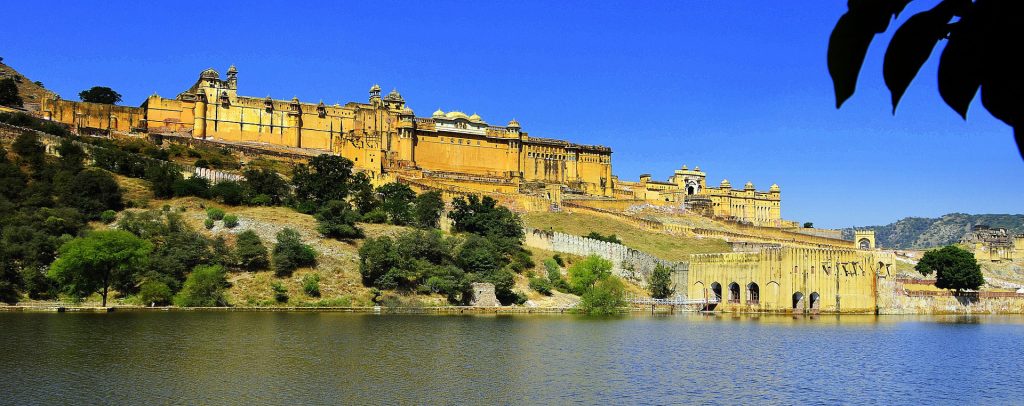
It is among the most famous Rajasthan Forts which is located 11 km from Jaipur, the Pink City of India. The Amber Fort, the ancient citadel of the ruling Kachhawa clan of Amber, is made up of white marble and red sandstone. The construction of this fort showcases the artistic Hindu and Mughal styles of decorations and constructions. This mighty fort is renowned for its impressive gates, temples, colossal ornate halls, palaces, pavilions, and beautiful gardens. The whole complex of this fort is covered with intricate carvings, mosaic, and minute mirror work that provides a majestic and imperial look to the fort. Some of the famous attractions of this fort are Diwan-e-Aam ‘Hall of Public Audience’, Suhaag Mandir, Sukh Niwas, Jas Mandir, Jai Mandir, and Ganesh Pol.
Nahargarh Fort, Jaipur
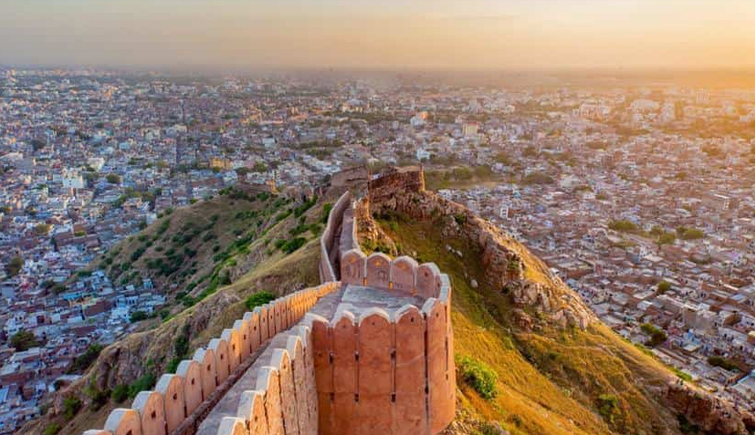
Nahargarh Fort is the first fort that was built by Sawai Raja Jai Singh and along with the Amber Fort and Jaigarh Fort to secure Amer from any kind of foreign aggression. An interesting legend is associated with the construction of this fort. It is said that when the construction of the fort started, the workers were bewildered to find all their previous day work destroyed every morning. A bit of finding revealed that the hill was haunted by the soul of a prince named Nahar and that he did not take nicely the intrusion of others in his abode. Raja Jai Singh, to placate the irate prince. A small fort was built to provide the soul a resting place. A shrine was also built and dedicated to the prince. Last but not least, the fort was named after this prince.
City Palace, Jaipur
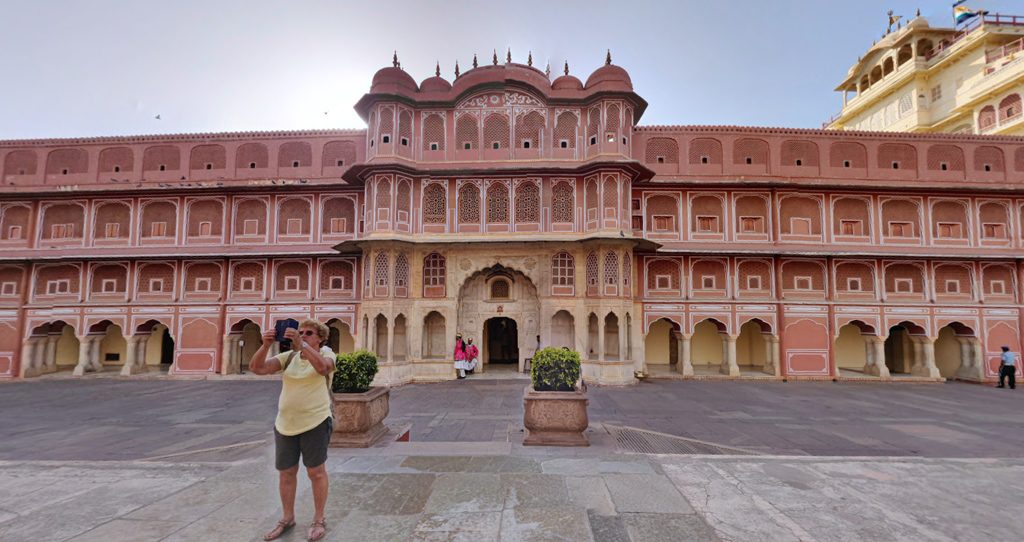
The pride of Jaipur, City Palace is a repertoire of royal articles belonging to the raja-maharajas of the bygone era. Tourists from all over the world are attracted to this palace is a major draw of the city. It is a perfect amalgamation of the traditional Rajasthani and Mughal styles of architecture. Every part of this imposing structure captures the hearts of onlookers. The rare artifacts inside the palace reflect the lifestyle of royal families who once lived here. Maharaja Jai Singh II built this architectural marvel. To add more charm to the palace new additions were made by his successors. The palace has huge courtyards, beautiful gardens, stunning halls, wonderful museums, magnificent temples, pavilions, and palaces. The highly notable and most visited places in this complex include City Palace museum, Shri Govind Dev temple, Maharani’s Palace, Mukut Mahal, Mubarak Mahal, and Chandra Mahal.
Rambagh Palace, Jaipur
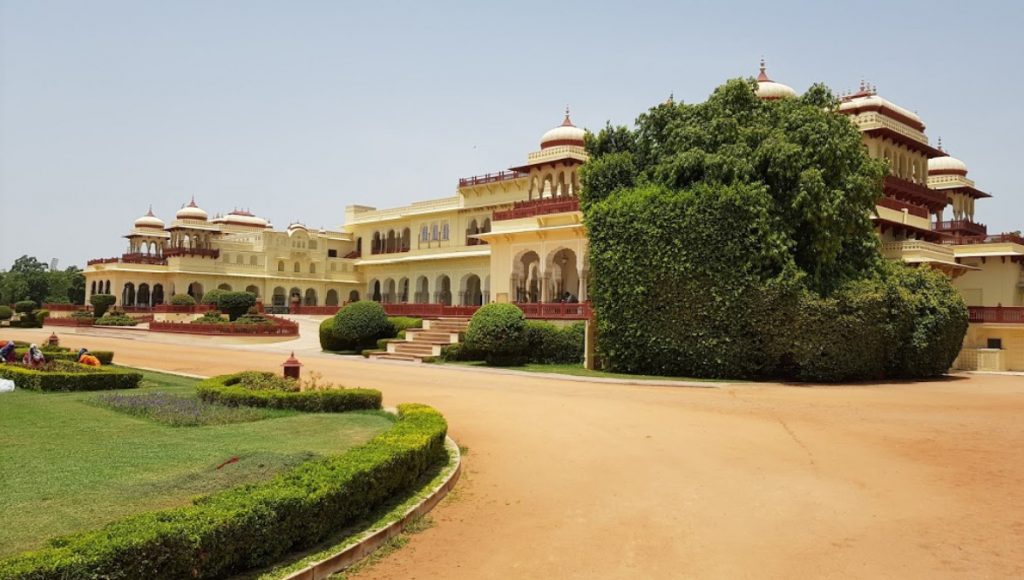
It was constructed in 1835 for Ram Singh. After Independence, this palace is employed as a royal resting place for king Sawai Man Singh and later on transformed to a Heritage hotel. With rich textures, gilded furnishings, and recherché objects, Rambagh Palace is often referred to as the “Jewel of Jaipur”. The expansive, ornamental gardens set up in outstanding symmetry have cut above the best parklands in the world. The mansion offers 79 rooms and strikingly furnished suites with elaborate décor with sheen fabrics and silk drapes and ardent hues reflecting Rajasthan’s stateliness. The distinctive dining experiences are all about savoring the finest of Indian and international cuisines. No wonder, it is hospitality personified and gifts once in a lifetime experience.
